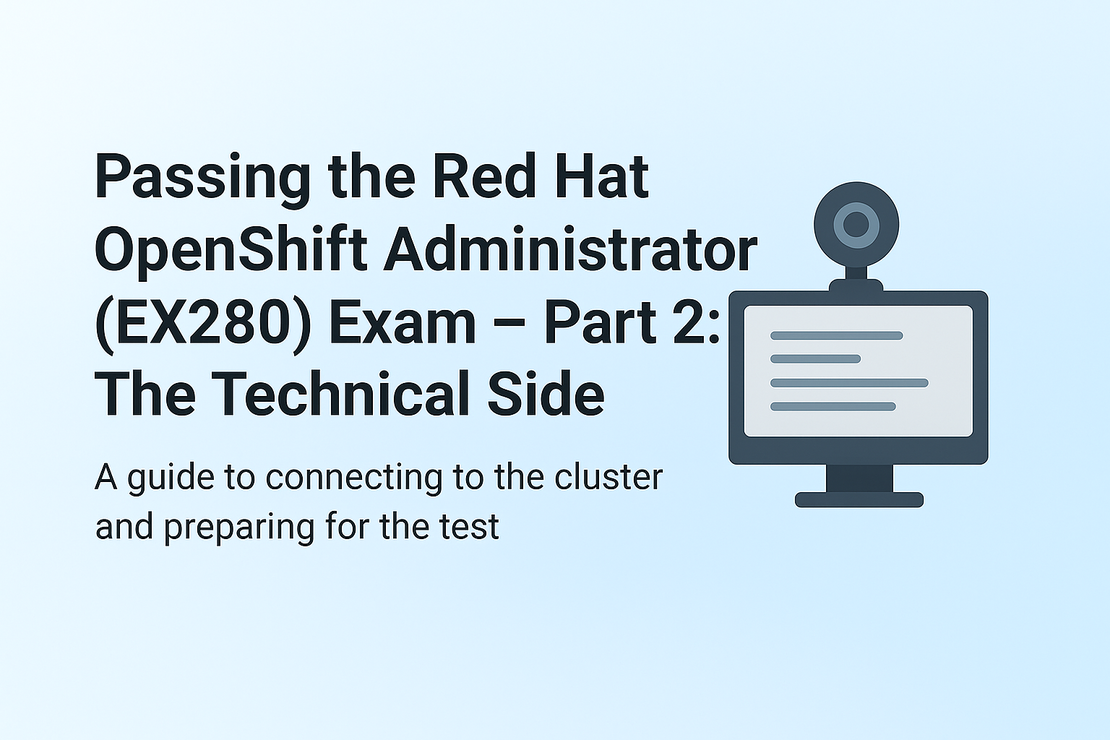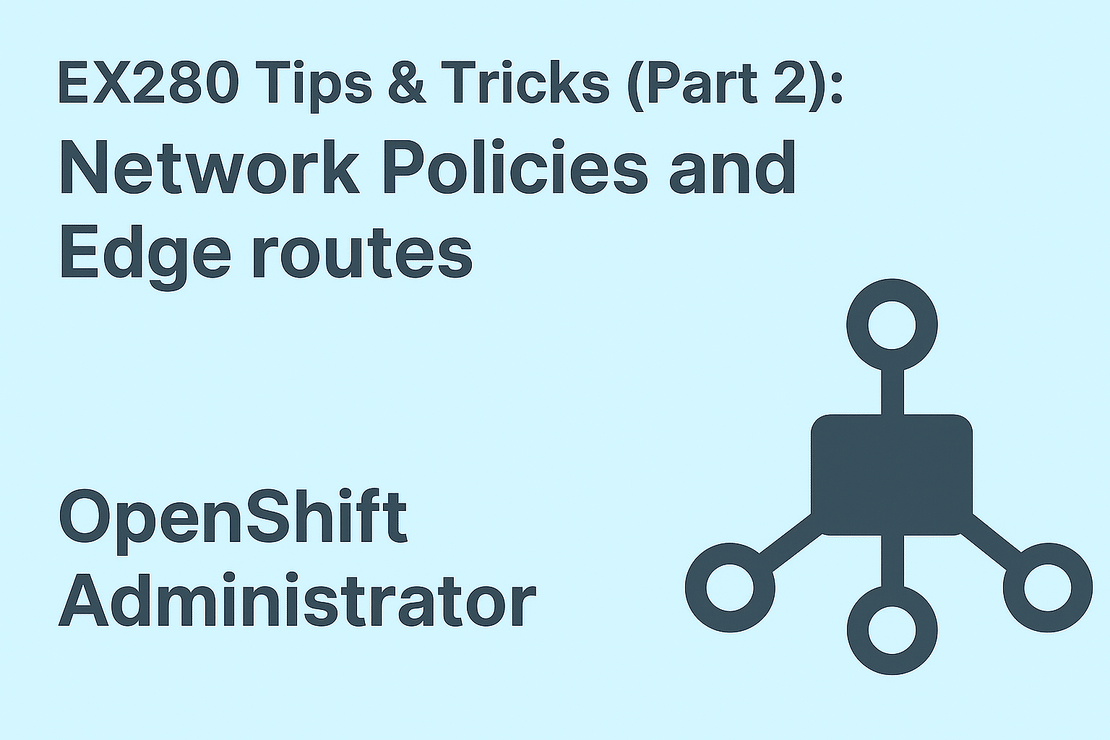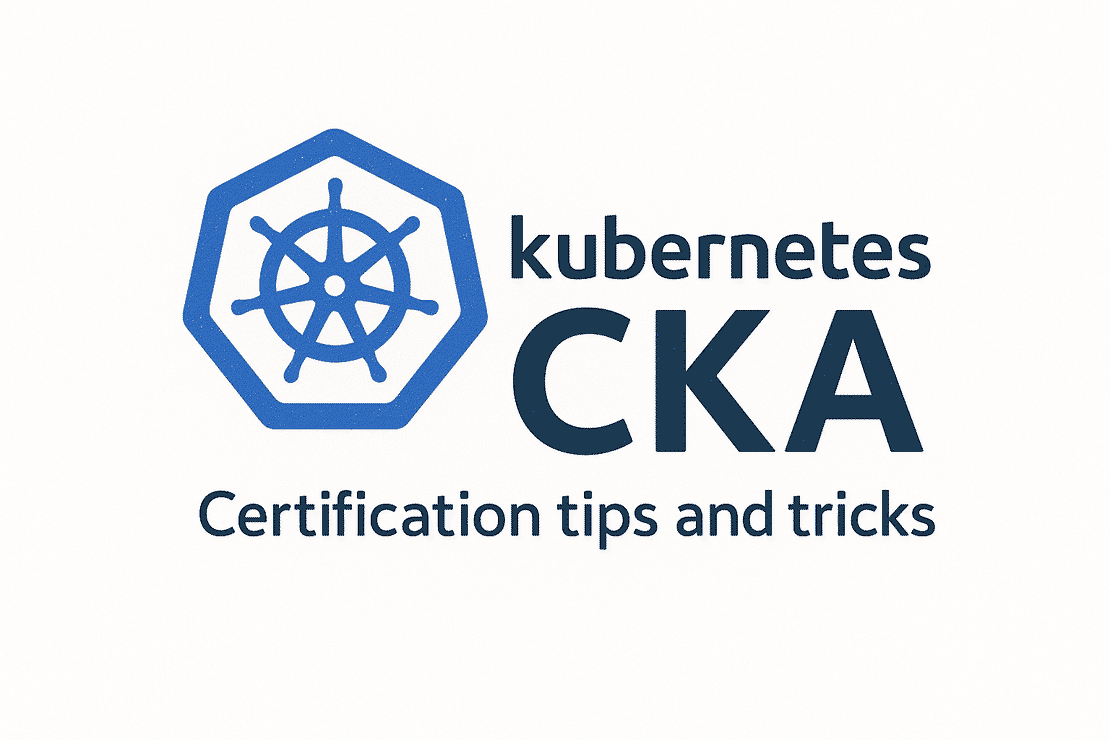
Passing the Red Hat OpenShift Administrator (EX280) Exam – Part 2: The Technical Side
- tharun-vempati
- Certifications , Dev ops , Red hat , Openshift , Administrator
- November 2, 2025
Table of Contents
Introduction
In Part 1, I covered the non-technical aspects of the Red Hat OpenShift Administrator (EX280) exam — setting up the remote environment, managing testing conditions, and handling pre-exam prep.
This second part focuses on the technical side — the hands-on components you’ll work on within the OpenShift cluster. If Part 1 was about preparing your environment, this one’s about executing with precision.
Before diving in, make sure you’ve completed these two key Red Hat courses:
- DO180 – OpenShift I: Containers, Kubernetes, and Red Hat OpenShift
- DO280 – OpenShift Administration II: Configuring a Production Cluster
DO180 teaches container fundamentals, storage, and health probes — topics that appear subtly in EX280.
DO280 dives deeper into cluster admin, networking, and troubleshooting — the exam’s core.
Understanding the Exam Setup
The EX280 exam runs for 3 hours, scores up to 300 points, and requires 70 % to pass.
Expect 21 – 23 real-world tasks executed directly on the OpenShift cluster.
Grading areas
- Manage OpenShift Container Platform
- Deploy Applications
- Manage Storage for Application Configuration and Data
- Configure Applications for Reliability
- Manage Authentication and Authorization
- Configure Network Security
- Enable Developer Self-Service
- Manage OpenShift Operators
- Configure Application Security
Although the exam centers on DO280, don’t ignore DO180 concepts such as storage and probes — they often reappear.
Smart Time Management
Three hours sounds plenty until you start typing.
- Around 21–23 questions ⇒ 7–8 per hour.
- Aim to finish 90 % within 2 hours, leaving an hour for verification.
My personal strategy
- Prioritize identity provider setup (
htpasswd) — time-consuming and error-prone. - Do Project Templates last — they can break project creation.
- Skip & return to tricky questions later.
- Use the console for visibility, CLI for accuracy.
Using the Open Book Advantage
EX280 is open book — you have access to Red Hat docs. But it’s not about reading; it’s about knowing where to look.
The two most useful pages:
- Manage Authentication and Authorization — for configuring
htpasswd. - Building Applications — for Project Template commands.
💡 Tip: Use
Ctrl + Fand minimal tabs. Practice navigation — speed comes from familiarity, not searching.
Connecting to the Cluster
At the start of the exam, connect to your OpenShift cluster using credentials shown on the Exam Environment Details page.
Once connected, verify with simple oc commands:
oc whoami
oc status
flowchart TD
A[Start Exam Environment] --> B[Connect to Remote Workstation]
B --> C[Login to OpenShift Cluster]
C --> D[Verify Connection with oc whoami / oc status]
D --> E[Begin Exam Tasks]
The Five Macro Areas of the Exam
Breaking the exam into five macro areas keeps preparation organized.
1. Authentication, Authorization & RBAC
Critical — and often time-consuming.
You should be able to:
- Configure
htpasswdidentity provider - Create users, groups, roles
- Assign cluster/project permissions
- Use
oc adm policyfor RBAC
Example:
oc create secret generic htpasswd-secret --from-file=htpasswd=/root/users.htpasswd -n openshift-config
oc patch oauth cluster --type=merge -p '{"spec":{"identityProviders":[{"name":"local","mappingMethod":"claim","type":"HTPasswd","htpasswd":{"fileData":{"name":"htpasswd-secret"}}}]}}'
oc adm groups new dev-team
oc adm groups add-users dev-team user1
🧩 Pro Tip: Practice
oc adm policybefore exam day — syntax familiarity saves time.
💡💡 Note: For further in depth information and tips on this topic please visit: EX280 Exam tips - Part 1
2. Network Security & Policies
Security is central to OpenShift admin.
Focus areas
- Create NetworkPolicies for pod-to-pod control
- Secure routes (
edge,reencrypt,passthrough) - Limit exposure with namespace + label selectors
Example:
apiVersion: networking.k8s.io/v1
kind: NetworkPolicy
metadata:
name: allow-web
namespace: frontend
spec:
podSelector:
matchLabels:
role: web
ingress:
- from:
- podSelector:
matchLabels:
role: backend
🔐 Pro Tip: Validate behavior with
oc execor console’s network graph.
💡💡 Note: For further in depth information and tips on this topic please visit: EX280 Exam tips - Part 2
3. Storage, ConfigMaps & Secrets
Essential crossover of DO180 + DO280.
Tasks
- Create and bind PVs/PVCs
- Mount volumes in deployments
- Use ConfigMaps & Secrets
- Work with StorageClasses
Example:
apiVersion: v1
kind: PersistentVolumeClaim
metadata:
name: app-data
spec:
accessModes:
- ReadWriteOnce
resources:
requests:
storage: 1Gi
storageClassName: gp2
🗂️ Pro Tip: After mounting,
oc rshinto the pod and check the mount point — that’s how graders confirm it works.
💡💡 Note: For further in depth information and tips on this topic please visit: EX280 Exam tips - Part 3
4. Deployments & Reliability
Expect to spend most of your time here.
Tasks
- Deploy via Helm or
oc new-app - Configure probes (liveness, readiness, startup)
- Set resource limits & autoscaling
- Use Service Accounts and SCCs
Example probe:
livenessProbe:
httpGet:
path: /health
port: 8080
initialDelaySeconds: 10
periodSeconds: 5
⚙️ Pro Tip: Use DO180 defaults for probes unless told otherwise.
💡💡 Note: For further in depth information and tips on this topic please visit: EX280 Exam tips - Part 4
5. Advanced Configuration & Developer Self-Service
Focus
- Create CronJobs
- Configure quotas and limit ranges
- Manage Project Templates
- Work with Operators
Example CronJob:
apiVersion: batch/v1
kind: CronJob
metadata:
name: cleanup
spec:
schedule: "*/10 * * * *"
jobTemplate:
spec:
template:
spec:
containers:
- name: cleanup
image: busybox
command: ["sh","-c","echo Cleaning up..."]
restartPolicy: OnFailure
🚨 Pro Tip: Prioritize Project Templates task at the last — misconfigurations can affect everything.
💡💡 Note: For further in depth information and tips on this topic please visit: EX280 Exam tips - Part 5
Managing OpenShift Operators
Operators simplify lifecycle management.
Tasks
- Install from OperatorHub
- Verify installation:
oc get csv -n openshift-operators
- Deploy resources via CRDs
📦 Pro Tip: You cannot (and should not) manually create a new namespace (Project) that begins with the openshift- prefix. These namespaces are reserved for core OpenShift cluster components and services.
In an exam scenario (or in a real-world environment), if you are asked to install an Operator that needs to be in a namespace like openshift-operators, it’s because that namespace already exists for its intended purpose (i.e., managing cluster-wide Operators). Your task would be to select that existing namespace during the installation, not to create it.
Recommended Workflow
- Connect and verify cluster access
- Configure auth & RBAC
- Set up storage and mounts
- Deploy and scale apps
- Apply network security
- Manage Operators & CronJobs
- Finish with Project Templates
- Validate everything before submission
Quick Recap
✅ Know DO180 and DO280 concepts
✅ Connect to cluster cleanly
✅ Set up htpasswd & RBAC
✅ Create PVs/PVCs, ConfigMaps, Secrets
✅ Deploy apps + probes
✅ Apply NetworkPolicies and routes
✅ Manage quotas, limits, CronJobs
✅ Install Operators
✅ Leave Project Template for last
Final Thoughts
The EX280 exam validates how effectively you can run OpenShift under real conditions.
- It’s open book — but mastery > search.
- Stick to clean commands, verify results.
- Stay calm and methodical.
You’ve practiced — now execute.
If you haven’t yet, revisit Part 1: The Non-Technical Side to ensure your exam setup is solid before the big day.
Authored by Tharun Vempati
Red Hat Certified OpenShift Administrator | DevOps Engineer


